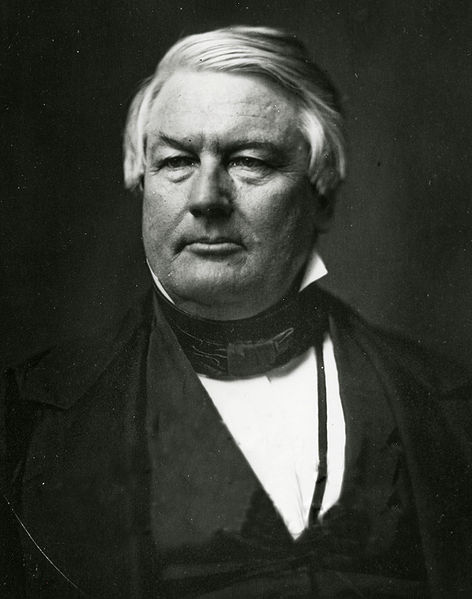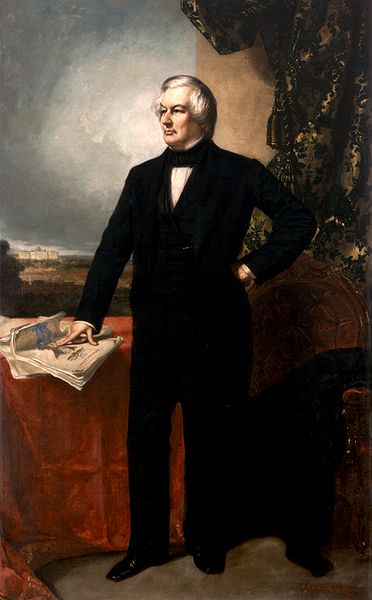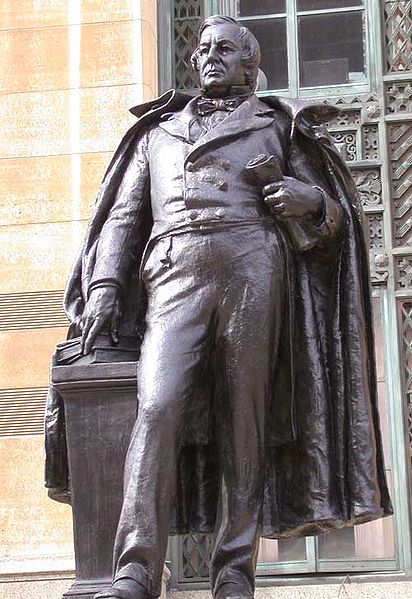<Back to Index>
- Inventor Sandford Fleming, 1827
- Composer Francis Jean Marcel Poulenc, 1899
- 13th President of the United States Millard Fillmore, 1800
PAGE SPONSOR



Millard Fillmore (January 7, 1800 – March 8, 1874) was the 13th President of the United States, serving from 1850 until 1853, and the last member of the Whig Party to hold that office. He became the second Vice President to assume the presidency after the death of a sitting president when he succeeded Zachary Taylor, who died of acute gastroenteritis. Fillmore was never elected president. After serving out Taylor's term, he failed to gain the nomination of the Whigs for president in the 1852 presidential election, and, four years later, in the 1856 presidential election, he again failed to win election as the Know Nothing Party and Whig candidate.
Millard Fillmore was born in a log cabin in Moravia, Cayuga County, in the Finger Lakes region of New York State on January 7, 1800, to Nathaniel Fillmore and Phoebe Millard, as the second of nine children and the eldest son. (As this was three weeks after George Washington's death, Fillmore was the first U.S. President born after the death of a former president.) He later lived in East Aurora, New York in the southtowns region, south of Buffalo. Though a Unitarian in later life, Fillmore's ancestors were Scottish Presbyterians on his father's side and English dissenters on his mother's. His father apprenticed him to a cloth maker in Sparta, New York, at age fourteen to learn the cloth-making trade. He left after four months, but subsequently took another apprenticeship in the same trade at New Hope, New York. He struggled to obtain an education living on the frontier and attended New Hope Academy for six months in 1819. Later that year, he began to clerk for Judge Walter Wood of Montville, New York, under whom Fillmore began to study law.
He fell in love with Abigail Powers, whom he met while at New Hope Academy and later married on February 5, 1826. The couple had two children, Millard Powers Fillmore and Mary Abigail Fillmore. After leaving Wood and buying out his apprenticeship, Fillmore moved to Buffalo, where he continued his studies in the law office of Asa Rice and Joseph Clary. He was admitted to the bar in 1823 and began his law practice in East Aurora where, in 1825, he built a house for his new bride. In 1834, he formed a law partnership, Fillmore and Hall (becoming Fillmore, Hall and Haven in 1836), with close friend Nathan K. Hall (who would later serve in his cabinet as Postmaster General). It would become one of western New York's most prestigious firms. It exists to this day as Hodgson Russ LLP.
In 1846, he founded the private University of Buffalo, which today is the public State University of New York at Buffalo (SUNY Buffalo), the largest school in the New York state university system.
His military service was limited; he served in the New York militia during the Mexican War of 1846 and during the American Civil War.
In 1828, Fillmore was elected to the New York State Assembly on the Anti-Masonic ticket, serving three one-year terms, from 1829 to 1831. In his final term he chaired a special legislative committee to enact a new bankruptcy law that eliminated debtors' prison. As the measure had support among some Democrats, he maneuvered the law into place by taking a nonpartisan approach and allowing the Democrats to take credit for the bill. This kind of inconspicuousness and avoiding the limelight would later characterize Fillmore's approach to politics on the national stage.
He later won election as a Whig (having followed his mentor Thurlow Weed into the party) to the 23rd Congress in 1832, serving from 1833 to 1835. He was reelected in 1836 to the 25th Congress, to the 26th and to the 27th Congresses serving from 1837 to 1843, declining to be a candidate for re-nomination in 1842. In Congress, he opposed admitting Texas as a slave territory. He came in second place in the bid for Speaker of the House of Representatives in 1841. He served as chair of the House Ways and Means Committee from 1841 to 1843 and was an author of the Tariff of 1842, as well as two other bills that President John Tyler vetoed.
After leaving Congress, Millard Fillmore was the unsuccessful Whig candidate for Governor of New York in 1844. He was the first New York State Comptroller elected by general ballot, and was in office from 1848 to 1849. As state comptroller, he revised New York's banking system, making it a model for the future National Banking System.
At the Whig national convention in 1848, the nomination of Gen. Zachary Taylor for president angered supporters of Henry Clay and opponents of allowing slavery in the territories gained in the Mexican – American War. A group of practical Whig politicians nominated Fillmore for vice president. Fillmore came from a non-slave state and delegates believed he would help the ticket carry the populous state of New York. Fillmore was also selected in part to block New York state machine boss Thurlow Weed from receiving the vice presidential nomination (and his front man William H. Seward from receiving a position in Taylor's cabinet). Weed eventually got Seward elected to the Senate. This competition between Seward and Fillmore led to Seward's becoming a more vocal part of cabinet meetings and having more of a voice than Fillmore in advising the administration. The battle would continue even after Taylor's death.
Taylor and Fillmore disagreed on the slavery issue in the new western territories taken from Mexico in the Mexican - American War. Taylor wanted the new states to be free states, while Fillmore supported slavery in those states to appease the South. In his own words: "God knows that I detest slavery, but it is an existing evil ... and we must endure it and give it such protection as is guaranteed by the Constitution."
Fillmore presided over the Senate during the months of nerve wracking debates over the Compromise of 1850. During one debate, Senator Henry S. Foote of Mississippi pulled a pistol on Senator Thomas Hart Benton of Missouri.
Fillmore made no public comment on the merits of the compromise
proposals. A few days before President Taylor's death, however,
Fillmore suggested to the president that he would vote in favor of the
North if the vote on Henry Clay's bill was tied.
After President Taylor died suddenly on July 9, 1850, Fillmore became president. The change in leadership also signaled an abrupt political shift. Fillmore had very different views on the slavery issue. Before Taylor's death, Fillmore told him that, as President of the Senate, he would give his tie-breaking vote to the Compromise of 1850. When Fillmore took office, the entire cabinet offered their resignations. Fillmore accepted them all and appointed men who, except for Treasury Secretary Thomas Corwin, favored the Compromise of 1850. When the compromise finally came before both Houses of Congress, it was very watered down. As a result, Fillmore urged Congress to pass the original bill. This move only provoked an enormous battle where "forces for and against slavery fought over every word of the bill." To Fillmore's disappointment the bitter battle over the bill crushed public support. Clay, exhausted, left Washington to recuperate, passing leadership to Senator Stephen A. Douglas of Illinois. At this critical juncture, President Fillmore announced his support of the Compromise of 1850.
On August 6, 1850, he sent a message to Congress recommending that Texas be paid to abandon its claims to part of New Mexico. This, combined with his mobilization of 750 Federal troops to New Mexico, helped shift a critical number of northern Whigs in Congress away from their insistence upon the Wilmot Proviso — the stipulation that all land gained by the Mexican War must be closed to slavery. Douglas's effective strategy in Congress combined with Fillmore's message to Congress gave momentum to the Compromise movement. Breaking up Clay's single legislative package, Douglas presented five separate bills to the Senate:
- Admit California as a free state.
- Settle the Texas boundary and compensate the state for lost lands.
- Grant territorial status to New Mexico.
- Place federal officers at the disposal of slaveholders seeking escapees — the Fugitive Slave Act.
- Abolish the slave trade, but not slavery, in the District of Columbia.
Each measure obtained a majority, and, by September 20, President Fillmore had signed them into law. Webster wrote, "I can now sleep of nights." Whigs on both sides refused to accept the finality of Fillmore's law (which led to more party division, and a loss of numerous elections), which forced Northern Whigs to say "God Save us from Whig Vice Presidents." Fillmore's greatest difficulty with the fugitive slave law was enforcing it without showing favor to Southern Whigs. His solution was to appease both northern and southern Whigs. He called for enforcing the fugitive slave law in the North, and enforcing in the South a law forbidding involvement in Cuba (for the sole purpose of adding it as a slave state).
Fillmore appointed Brigham Young as the first governor of the Utah Territory in 1850. In gratitude for creating the Utah Territory in 1850 and appointing Brigham Young as governor, Young named the territorial capital "Fillmore" and the surrounding county "Millard". Fillmore, a bookworm, started the White House library when he found the White House devoid of books.
On the foreign policy front Fillmore was particularly active in the Asian Pacific, especially Japan. American shipping interests had become more keen on opening Japan up to outside trade because it would allow them to stop for supplies en route to China and Southeast Asia. American shippers also looked to the British opening of China to trade as an example of the "benefits of new trade markets." Fillmore, with help from Secretary of State Daniel Webster, sent Commodore Matthew C. Perry to open Japan to Western trade. Though Perry did not reach Japan until Franklin Pierce had replaced Fillmore as president, Fillmore earns the credit for ending Japanese isolation because it was he who ordered the trade mission. Fillmore was also a staunch defender against foreign intervention in Hawaii. France's Napoleon III attempted to annex the Hawaiian Islands, but was forced to withdraw after a strongly worded message from Fillmore suggesting that "the United States would not stand for any such action."
Though President Taylor had signed the Clayton - Bulwer Treaty preventing Britain and the US from taking more possessions in the Americas, Great Britain and the United States were still attempting to gain ground in the region. The situation became tense enough that Fillmore ordered several warships to guard American merchants in an attempt to prevent British interference. Fillmore was also caught in a situation involving Cuba. Many southerners were eager to expand the bounds of slavery and since slavery territories were locked down because of the Compromise of 1850, many southerners turned to the Caribbean. Venezuelan Narciso López gathered a small force of Americans to invade Cuba. Though Fillmore tried to block such efforts, he was nevertheless unsuccessful as López managed to sail out of New Orleans. Despite the invasions failure, López tried another invasion a year later which came to a quick end after Spanish troops routed them from the island. The incident became particularly embarrassing for Fillmore because southerners felt Fillmore should have supported the invasion, while Northern democrats were upset at his apology to the Spanish. In response the French and British dispatched warships to the region. Fillmore sent a stern warning saying that under certain conditions control of Cuba "might be almost essential to our [America's] safety."
Another issue that presented itself during Fillmore's presidency was the arrival of Lajos Kossuth (exiled leader of a failed Hungarian revolution).
Kossuth wanted the United States to abandon its nonintervention
policies when it came to European affairs and recognize Hungary's
independence. The problem came with the enormous support Kossuth
received from German - American immigrants to the United States (who
were
essential in the reelection of both Whigs and Democrats). Fillmore
refused to change American policy, and decided to remain neutral
despite the political implications that neutrality would produce.
Fillmore was one of the founders of the University of Buffalo. The school was chartered by an act of the New York State Legislature on May 11, 1846, and at first was only a medical school. Fillmore was the first Chancellor, a position he held while both Vice President and President. After leaving office, Fillmore returned to Buffalo and continued to serve as chancellor of the school.
After the death of his daughter Mary, Fillmore went abroad. While touring Europe in 1855, Fillmore was offered an honorary Doctor of Civil Law (D.C.L.) degree by the University of Oxford. Fillmore turned down the honor, explaining that he had neither the "literary nor scientific attainment" to justify the degree. He is also quoted as having explained that he "lacked the benefit of a classical education" and could not, therefore, understand the Latin text of the diploma, adding that he believed "no man should accept a degree he cannot read."
By
1856, Fillmore's Whig Party had ceased to exist, having fallen apart
due to dissension over the slavery issue, and especially the Kansas - Nebraska Act of 1854. Fillmore refused to join the new Republican Party, where many former Whigs, including Abraham Lincoln, had found refuge. Instead, Fillmore joined the anti-immigrant, anti-Catholic American Party, the political organ of the Know-Nothing movement. He ran in the election of 1856 as
the party's presidential candidate, attempting to win a nonconsecutive
second term as President (a feat accomplished only once in American
politics, by Grover Cleveland). His running mate was Andrew Jackson Donelson, nephew of former president Andrew Jackson.
Fillmore and Donelson finished third, carrying only the state of
Maryland and its eight electoral votes; but he won 21.6% of the popular
vote, one of the best showings ever by a Presidential third party candidate.
On February 10, 1858, after the death of his first wife, Fillmore married Caroline McIntosh, a wealthy widow. Their combined wealth allowed them to purchase a big house in Buffalo, New York. The house became the center of hospitality for visitors, until her health began to decline in the 1860s.
Fillmore helped found the Buffalo Historical Society (now the Buffalo and Erie County Historical Society) in 1862 and served as its first president.
Throughout the Civil War, Fillmore opposed President Lincoln and during Reconstruction supported President Johnson. He commanded the Union Continentals, a corps of home guards of males over the age of 45 from the Upstate New York area.
He died at 11:10 p.m. on March 8, 1874, of the aftereffects of a stroke.
His last words were alleged to be, upon being fed some soup, "the
nourishment is palatable." On January 7 each year, a ceremony is held
at his grave site in the Forest Lawn Cemetery in Buffalo.
Some northern Whigs remained irreconcilable, refusing to forgive Fillmore for having signed the Fugitive Slave Act.
They helped deprive him of the Presidential nomination in 1852. Within
a few years it was apparent that although the Compromise had been
intended to settle the slavery controversy, it served rather as an
uneasy sectional truce. Robert J. Rayback argues that the appearance of
a truce, at first, seemed very real as the country entered a period of
prosperity that included the South. Although
Fillmore, in retirement, continued to feel that conciliation with the
South was necessary and considered that the Republican Party was at
least partly responsible for the subsequent disunion, he was an
outspoken critic of secession and was also critical of President James Buchanan for not immediately taking military action when South Carolina seceded.
Benson Lee Grayson suggests that the Fillmore administration's ability to avoid potential problems is too often overlooked. Fillmore's constant attention to Mexico avoided a resumption of the hostilities that had only broken off in 1848 and laid the groundwork for the Gadsden Treaty during Pierce's administration. Meanwhile, the Fillmore administration resolved a serious dispute with Portugal left over from the Taylor administration, smoothed over a disagreement with Peru, and then peacefully resolved other disputes with England, France, and Spain over Cuba. At the height of this crisis, the Royal Navy had fired on an American ship while at the same time 160 Americans were being held captive in Spain. Fillmore and his State Department were able to resolve these crises without the United States going to war or losing face.
Because the Whig party was so deeply divided, and the two leading national figures in the Whig party (Fillmore and his own Secretary of State, Daniel Webster) refused to combine to secure the nomination, Winfield Scott received it. Because both the north and the south refused to unite behind Scott, he won only 4 of 31 states, and lost the election to Franklin Pierce.
After Fillmore's defeat the Whig party continued its downward spiral with further party division coming at the hands of the Kansas Nebraska Act, and the emergence of the Know Nothing party.
His correspondence is available at Penfield Library of the State University of New York at Oswego.



